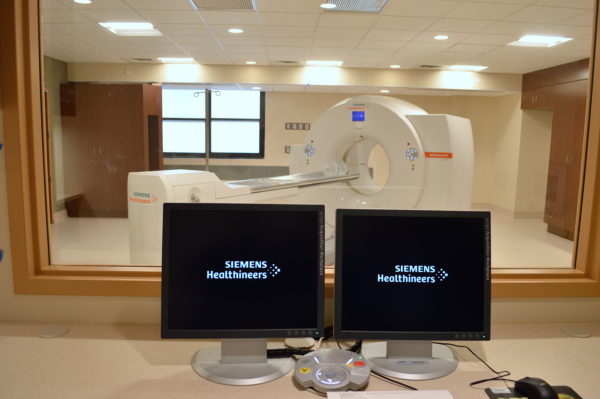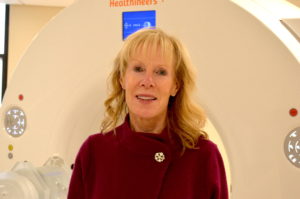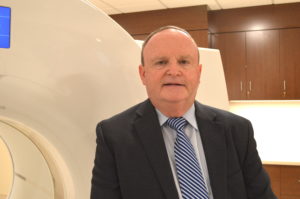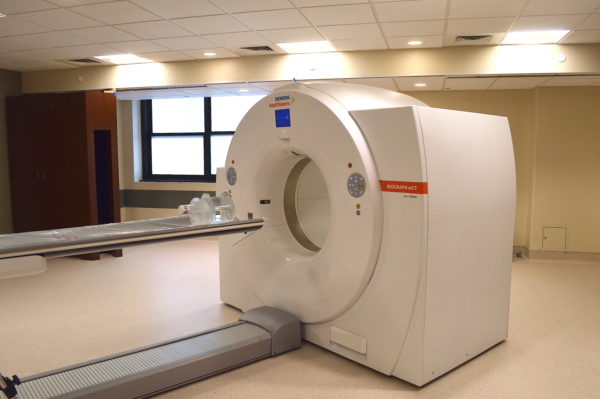At Phelps Hospital in Sleepy Hollow, they’re putting the finishing touches on a new $8.4 million PET/CT imaging suite expected to be operational in February. It houses a scanner manufactured by Seimens Healthineers that simultaneously does Positron Emission Tomography (PET) and Computerized Tomography Imaging (CT) imaging. Obtaining both PET and CT images previously required two separate sessions using two separate pieces of equipment.

Phelps is a Northwell Health hospital and the new 3,800-square-foot imaging suite will be used in the treatment of patients at the Northwell Health Cancer Institute at Phelps. In addition, patients being diagnosed and treated for issues such as cardiac problems, seizures and dementia will undergo imaging procedures there. The new imaging suite is located on the first floor of the hospital, not far from the lobby at the hospital’s main entrance.
“It’s very exciting because we’re able to fully enhance our radiological capabilities here, our imaging studies, but even more importantly we’re going to be able to add to our cancer center and be able to provide care for our cancer patients that we otherwise weren’t able to,” Eileen Egan, executive director of Phelps, told the Business Journal. “It seems to be becoming standard of care for cancer patients to have PET/CT and we’ve had to refer them elsewhere and now they can get it right here at Phelps.”

Egan said that one of the things they’re proudest of at Phelps is that the new equipment makes it possible for patients needing PET/CT imaging to no longer have to go into Manhattan or travel elsewhere to find an imaging source.
Egan explained that when ordinary X-rays or an MRI scan are not able to help physicians pinpoint problems affecting patients, PET/CT imaging may be useful.
“It’s an advanced level of imaging that really may help identify any problems that may otherwise not have been picked up by other imaging modalities,” Egan said. “The equipment is very expensive but we anticipate with the volume of patients that we’re going to be able to see and treat we know it’s going to pay for itself very quickly.”
She said that a constant goal when designing the new imaging center was patient comfort.
“If they require this type of imaging, we want them to feel comfortable in the environment,” Egan said. “This space is very spacious. It’s open, there’s light, there are windows. We want our patients not to feel claustrophobic when they’re having their testing done.”

Egan said that the new imaging center coincides with other efforts at Phelps to expand the services it offers to the community.
“We are proud to be developing a Center for Advanced Procedures which is going to be focused on neurosciences and neuroendovascular cases, so this is all part of that, but this particularly is part of our plans to develop a comprehensive cancer center in Westchester on the Phelps campus and this will greatly enhance our oncologists’ ability to diagnose and treat cancer,” Egan said. In the term “neuroendovascular,” neuro refers to the nervous system (brain, spinal cord, nerves) and endovascular refers to being inside the blood vessels.
Michael Glennon, assistant vice president, operations, ancillary services at Phelps, told the Business Journal, “I’ve been in radiology most of my life. I actually started out hand-developing X-ray films in tanks. Now, it’s all electronic, all digital. Everything can be sent and seen anywhere.”
Glennon explained that with digital files rather than pieces of physical film you can have an expert on Long Island or elsewhere at Northwell instantaneously see the images and collaborate in developing a diagnosis or treatment plan.

He said that the lighting level in the imaging center can be adjusted to help the patient relax and music also can be used if the patient wishes. Glennon pointed out that the scanner uses a wide bore, or opening into which the patient is moved, to help reduce patient anxiety and overcome issues that patients had with earlier scanners that put them into a tight tunnel.
“Our technologists already know the CT scan technology and we’ve hired another nuclear medicine technologist that knows the PET side of it, so combined there will be two experts in the room always working the equipment,” Glennon said. “The procedures vary from about 20 minutes to about 45 minutes. You’re getting a radiopharmaceutical injection in your arm and then you lay on the table. It’s very easy. It used to be over an hour. It’s down to about 20 minutes now for most procedures.”
A radiopharmaceutical is a drug that contains radioactive material. It emits radiation that is detected by the imaging equipment.
Glennon explained that where standard X-rays show shadows, the PET/CT scans show not only distinct images but also the chemical makeup because the radiopharmaceutical agents actually attach to different cells within the body and they show up in different colors and intensities.
“We can see the intensity, we can see the width, the depth, 3D, it’s all calculated,” Glennon said. “We’ve come through so many levels of technology over the years. This is quite amazing. I never thought we’d be here. When you see the 3D imaging it’s quite amazing.”


















